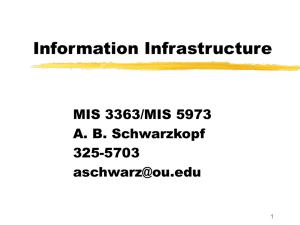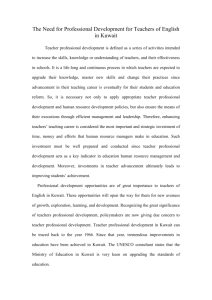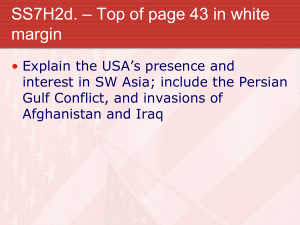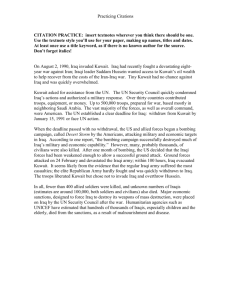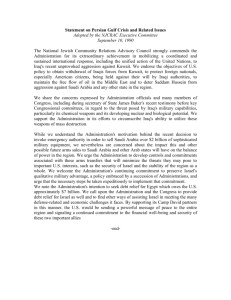TECHNOLOGY’S CHILD: SCHWARZKOPF AND OPERATION DESERT STORM BACKGROUND
advertisement
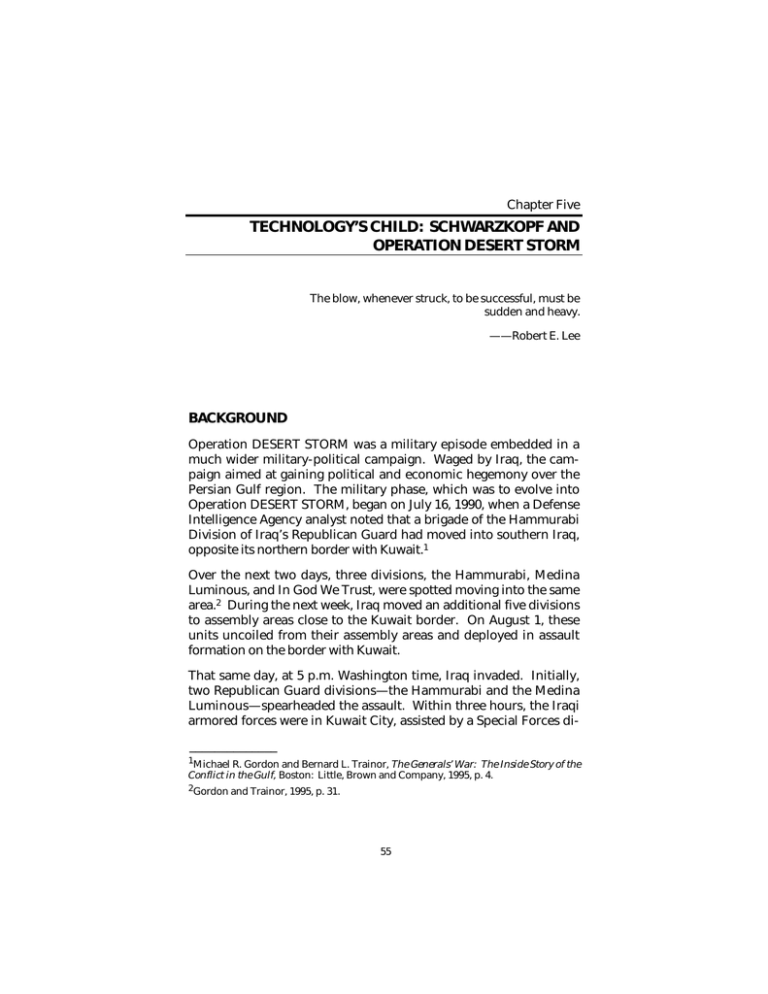
Chapter Five TECHNOLOGY’S CHILD: SCHWARZKOPF AND OPERATION DESERT STORM The blow, whenever struck, to be successful, must be sudden and heavy. ——Robert E. Lee BACKGROUND Operation DESERT STORM was a military episode embedded in a much wider military-political campaign. Waged by Iraq, the campaign aimed at gaining political and economic hegemony over the Persian Gulf region. The military phase, which was to evolve into Operation DESERT STORM, began on July 16, 1990, when a Defense Intelligence Agency analyst noted that a brigade of the Hammurabi Division of Iraq’s Republican Guard had moved into southern Iraq, opposite its northern border with Kuwait.1 Over the next two days, three divisions, the Hammurabi, Medina Luminous, and In God We Trust, were spotted moving into the same area.2 During the next week, Iraq moved an additional five divisions to assembly areas close to the Kuwait border. On August 1, these units uncoiled from their assembly areas and deployed in assault formation on the border with Kuwait. That same day, at 5 p.m. Washington time, Iraq invaded. Initially, two Republican Guard divisions—the Hammurabi and the Medina Luminous—spearheaded the assault. Within three hours, the Iraqi armored forces were in Kuwait City, assisted by a Special Forces di______________ 1 Michael R. Gordon and Bernard L. Trainor, The Generals’ War: The Inside Story of the Conflict in the Gulf, Boston: Little, Brown and Company, 1995, p. 4. 2 Gordon and Trainor, 1995, p. 31. 55 56 Command Concepts vision that had been airlifted into the city itself.3 As Iraqi armored units piled up on the roads in and around Kuwait City, the ultimate intentions of the Iraqi leadership remained unclear. By midday on August 3, however, the Iraqis had sorted themselves out and were clearly moving south, threatening the security of Saudi Arabia. As the situation was developing during the run-up to the invasion, the Chairman of the Joint Chiefs of Staff, General Colin Powell, had instructed the Commander in Chief of Central Command (CINCCENTCOM), General H. Norman Schwarzkopf, to prepare a two-tiered set of military options to respond to a potential invasion: a set of defensive options to protect Saudi Arabia, and a set of offensive options to take the war to the Iraqis if necessary. On August 4, Schwarzkopf briefed President George Bush on CENTCOM’s contingency war plan, OPLAN 90-1002 (or “ten-oh-two”), which laid down the force requirements for defending Saudi Arabia, and the transport, logistics, and time required to get them there. It envisioned a 17week deployment of three Army divisions, two Marine Expeditionary Forces, and three carrier battle groups to the Persian Gulf—over 200,000 soldiers in all.4 Ten-oh-two was briefed to several groups of policymakers. Finally, President Bush instructed Defense Secretary Dick Cheney to discuss with King Fahd of Saudi Arabia the idea that a massive influx of U.S. military power might be necessary to secure the kingdom. After several days of negotiations, the Saudis agreed to allow the U.S. military to deploy to the Saudi kingdom to deter an attack on Saudi Arabia. At 4 p.m. in Washington on August 7, General Powell received the authorization to execute OPLAN 90-1002. Immediately, two squadrons (48 aircraft) of F-15 fighters and the Division Ready Brigade of the 82d Airborne Division (2,300 soldiers) deployed to Saudi Arabia, arriving at Dhahran on August 8. Two carrier battle groups arrived onstation at the same time. By mid-September, the air deployment was almost complete, with over 700 aircraft in place.5 Over the following 14 weeks, an additional 230,000 troops arrived. On December 1, ______________ 3 Lawrence Freedman and Ephraim Karsh, The Gulf Conflict, 1990–1991: Diplomacy and War in the New World Order, Princeton: Princeton University Press, 1993, p. 67. 4 Gordon and Trainor, 1995, p. 46. 5 Freedman and Karsh, 1993, p. 94. Technology’s Child: Schwarzkopf and Operation DESERT STORM 57 General Schwarzkopf reported to the President that he had accomplished his mission. A force adequate to deter an Iraqi invasion of Saudi Arabia was in place. Halfway through this process, policymakers in Washington pressed General Powell to develop an offensive option—to take the war to the Iraqis and push them out of Kuwait. On October 10 and 11, Schwarzkopf’s deputy, Marine Major General Robert B. Johnston, briefed a rough outline of an offensive plan to the Joint Chiefs and to President Bush.6 General Powell telephoned Schwarzkopf and asked him what he would need in resources for the offensive option. Schwarzkopf asked Powell for two more ground divisions—specifically, the U.S. VII Corps, which at that time was stationed in Germany. On October 31, at a White House meeting, General Powell presented Schwarzkopf’s “shopping list” to President Bush, along with the caution that it would take an additional three months to get the troops in place for an offensive operation. President Bush agreed to provide the forces necessary for the task, and, on November 1, issued the order. 7 Powell gave Schwarzkopf all he had asked for, and more. He ordered the services in response to send three extra Army divisions, a second Marine division, two more carrier battle groups (for a total of six), and over 300 more Air Force aircraft—approximately twice the force that was currently in-country.8 At the same time, the United States was successfully marshaling a coalition of nations to support actions against Iraq with the aims of (1) garnering world (and United Nations) approval, (2) keeping the conflict from being seen as an American or Western versus Arab or Islamic conflict, and (3) preventing Israeli involvement, a lightning rod for Arab hostility. The resulting political coalition and the appearance of a military coalition were essential to the success of Operation DESERT STORM. However, despite the significant military participation by other nations, military operations were domi______________ 6 Gordon and Trainor, 1995, pp. 129, 132–134. 7 Gordon and Trainor, 1995, pp. 153–154. 8 H. Norman Schwarzkopf and Peter Petre, It Doesn’t Take a Hero, New York: Bantam, 1992, p. 376. 58 Command Concepts nated by U.S. forces and their logistics support. Thus, the descriptions that follow are centered on the U.S. coalition commander and U.S. military operations. THE PLANS Prior to the invasion, Iraq had three publicly stated goals. The first was a demand for adjustments to the Kuwait border in favor of Iraq. The second was forgiveness of Iraq’s $40 billion war debt with Kuwait. The third was cession to Iraq of control of the islands of Warba and Bubiyan, which controlled the approaches to the mouth of the Euphrates River, and thus to Iraq.9 After the invasion, annexation of Kuwait as Iraq’s “nineteenth province” was added. Iraq’s strategic objective was to terminate any hostilities so that she would be holding more than she had started with—territory, wealth, and prestige. Iraq’s operational objectives were to hang onto as much Kuwaiti territory as possible, by inflicting sufficient punishment on the coalition forces to cause them to sue for peace: A strategy of intensive defense, conceding no ground without a hard fight, was Saddam’s best hope of achieving his political objective of holding on to as much of Kuwait as possible. The higher the costs imposed, the more the enemy would be prepared to accept a peace on terms that were unobtainable prior to hostilities. . . . [T]o this end, Iraqi forces barricaded themselves into Kuwait. They constructed a massive defensive line close to the border with Saudi Arabia, a mixture of obstacles designed to stop a tank offensive, with coastal defenses prepared to repulse an amphibious assault.10 The Iraqis had 1,127 aircraft; a ground force of 900,000 soldiers in 63 divisions, 8 of which were of the Republican Guard; 5,747 tanks, 1,072 of which were modern T-72s; 10,000 armored fighting vehicles, including 1,600 modern BMPs (Soviet armored personnel carriers); and 3,500 artillery tubes. With this force at their disposal, the Iraqi Armed Forces’ General Command calculated that the United States ______________ 9 Gordon and Trainor, 1995, p. 27. 10Freedman and Karsh, 1993, p. 278. Technology’s Child: Schwarzkopf and Operation DESERT STORM 59 would need a force three times as large—or 3 million soldiers—to throw it out of Kuwait.11 A great deal of uncertainty was expressed among U.S. decisionmakers about the level of risk involved in an offensive campaign. Many voices were raised, warning of huge numbers of potential casualties. A key question that surfaced repeatedly was whether waging an air-only campaign would reduce risks to U.S. forces. General Powell was steadfast in his adamant opposition to that idea: Many experts, amateurs, and others in this town, believe that this can be accomplished by such things as surgical air strikes or perhaps a sustained air strike. And there are a variety of other nice, tidy, alleged low-cost, incremental, may-work options that are floated around with great regularity all over this town [but] one can hunker down, one can dig in, one can disperse to ride-out such a single-dimension attack. . . . Such strategies are designed to hope to win, they are not designed to win. 12 The fundamental flaw, he argued, was to leave the initiative with the Iraqi president: He makes the decision whether he will or will not withdraw. He decides whether he has been punished enough so that it is now necessary for him to reverse his direction and take a new political tack.13 By the end of October, President Bush had become firmly convinced that an offensive to drive the Iraqis out of Kuwait was necessary.14 To accomplish this objectives, the CENTCOM planners came up with a four-phase plan: ______________ 11Freedman and Karsh, 1993, pp. 279–280. This belief was apparently based on the military rule of thumb that a head-on attack into a prepared defense requires a preponderance of three times the defending force for the attacker to prevail—and even then at great cost. 12 General Powell’s testimony before the Senate Armed Services Committee, December 3, 1991, cited in Bob Woodward, The Commanders, New York: Pocket Books, 1992, p. 329. 13Freedman and Karsh, 1993, p. 286. 14Gordon and Trainor, 1995, p. 153. 60 Command Concepts • Phase 1 was to last between seven and ten days, and was intended to achieve air supremacy and incapacitate Iraq’s command and control system. This phase was to be executed by strategic air activity. • Phase 2 was intended to last several additional days, and was aimed at Iraq’s warmaking ability—primarily at weapons of mass destruction (nuclear, biological, and chemical), the eight Republican Guard divisions, and 12 major petrochemical facilities, including three refineries. • Phase 3 was intended to be an intense bombing campaign in Kuwait proper, aimed at disrupting, demoralizing, and destroying as many of the 400,000 troops occupying Kuwait as possible. • Phase 4 was a ground campaign designed to surround, isolate, and defeat in detail the Iraqi occupation forces in Kuwait:15 Since Saddam had most of his forces in southern Kuwait and along the Gulf coast to the east, the ground plan called for moving VII Corps several hundred miles in a wide arc to the west, and attacking through Iraq to hit the Republican Guard. It would amount to a gigantic left hook. Massive, swift, crushing tank attacks were central to the plan. . . . The idea was to force Saddam to move his hundreds of thousands of troops from dug-in positions so they could be picked-off with superior US air and ground fire. 16 After Schwarzkopf was informed of which units he would have at his disposal for an offensive operation, he assembled their commanders in Dhahran on November 14 to brief them on his intent: The first thing we’re going to have to do is, I don’t like to use the word ‘decapitate,’ so I think I’ll use the word ‘attack,’ leadership, and go after his command and control. Number two, we’ve got to gain and maintain air superiority. Number three, we’ve got to totally cut his supply lines. We also need to destroy his chemical, biological, and nuclear capability. And finally, all you tankers, listen to this. We need to destroy—not attack, not damage, not surround—I want you to destroy the Republican Guard. When ______________ 15Freedman and Karsh, 1993, p. 301. 16Schwarzkopf and Petre, 1992, p. 352. Technology’s Child: Schwarzkopf and Operation DESERT STORM 61 you’re done with them, I don’t want them to be an effective fighting force anymore. I don’t want them to exist as a military organization.17 Schwarzkopf then continued by explaining how CENTCOM would accomplish this task (see Figure 5.1): I anticipated, I said, a four-pronged ground assault. Along the Saudi-Kuwaiti border near the gulf, I wanted two divisions of US Marines and a Saudi task force to thrust straight into Kuwait, with the objective of tying up Saddam’s forces and eventually encircling Kuwait City. . . . I’d reserved a second corridor, in the western part of Kuwait, for a parallel attack by the pan-Arab forces led by two armored divisions from Egypt and another Saudi task force. Their objective would be the road junction north of Kuwait City that controlled the Iraqi supply lines. . . . I indicated a section of Saudi-Iraqi border more than three hundred and fifty miles inland. . . . I wanted Luck’s [XVIII Airborne Corps] divisions to race north from that area to the Euphrates, blocking the Republican Guard’s last route of retreat. . . . Finally, I turned to Fred Franks [Commander VII Corps]. “I think it’s pretty obvious what your mission’s going to be,” I said, moving my hand across the desert corridor just to the west of Kuwait, “attack through here and destroy the Republican Guard.”18 For deception, Schwarzkopf instructed XVIII Airborne Corps and VII Corps to maintain their forces in assembly areas near Kuwait, to keep Iraqi forces focused on those two avenues of approach. As soon as the air war began, the Iraqis would be pinned down and both corps would shift laterally several hundred miles to the west without interference.19 On December 29, Defense Secretary Cheney signed the Warning Order to implement DESERT STORM, with a target date for the initiation of the air campaign of January 15, 1991. At 1030 hours on January 15, President Bush met with his advisers to discuss the text of a National Security Directive (NSD) authorizing the execution of ______________ 17Schwarzkopf and Petre, 1992, p. 381. 18Schwarzkopf and Petre, 1992, pp. 382–383. 19Schwarzkopf and Petre, 1992, p. 383. XX Khawr Zubayr IRAN Shattal Arab 101 XX 82 Khawr 'Abd Allah KUWAIT Al Jahrah XX Bubiyan Kuwait Bay Kuwait 24 XX Al Magwa 1 XX XX 3 Faylakah Hawalli Mina Al Ahmadi Al Ahmadi Persian Gulf Ash Shu'aybah SYR XX XX SA XX 3 BRG EGY Khawr al Mutattah Scale 0 25 km 50 XX 1 CAV SAUDI ARABIA XX 1 MD XX 2 MD Figure 5.1—Schwarzkopf’s Concept Utopia R ✺❁❐❆ Command Concepts Abadan IRAQ 62 RANDMR775-5.1 To Euphrates River Technology’s Child: Schwarzkopf and Operation DESERT STORM 63 DESERT STORM. The President approved the NSD, and Powell and the Secretary of Defense signed the execute order at 5 p.m. Washington time, authorizing General Schwarzkopf to initiate Operation DESERT STORM at 3 a.m. Riyadh time on January 17.20 THE CAMPAIGN On January 17 at 1:30 a.m. in the Persian Gulf, the USS Bunker Hill fired a Tomahawk missile, the first of 106 Tomahawks that would be launched into Iraq during the first 24 hours of the war. The air campaign moved into high gear, achieving air superiority, blinding Iraqi C2 systems, and attacking strategic targets. Schwarzkopf decided to transition to Phase 3 on the fifteenth day of the bombing campaign: After two weeks of war, my instincts and experience told me that we’d bombed most of our strategic targets enough to accomplish our campaign objectives; it was now time, I thought, to shift most of our air power on to the army we were about to face in battle.21 By February 8, the two corps had almost completed their move to the west and were occupying attack positions. Schwarzkopf calculated that the mountains of logistics material and the remaining units would be in place within ten days. He informed Secretary Cheney, who was in Riyadh for a briefing, that he would be ready to go anytime after February 21. On February 24 at 4 a.m., the coalition forces attacked on the ground. Operation DESERT STORM lasted 42 days. The three air phases took 38 days. The Iraqi air defenses, command and control centers, and air forces were quickly neutralized. Many strategic targets, including some in Baghdad itself, were successfully attacked. An improvised but very effective attack against a deep-underground Iraqi C2 bunker produced an unexpected and embarrassing number of civilian casualties among those who had supposedly taken refuge there. The Iraqis employed ballistic missiles in attacks upon Saudi Arabia and Israel. Although those attacks proved of little military significance, their political consequences proved very distracting to the air effort. ______________ 20Gordon and Trainor, 1995, p. 206. 21Schwarzkopf and Petre, 1992, p. 430. 64 Command Concepts The coalition efforts to defend against those ballistic-missile attacks were mirror images—of more political than military effect. The bombing of Iraqi forces in Kuwait was relentless, but was probably more demoralizing that lethal in its effects. The ground war lasted just 100 hours before President Bush, in consultation with his military commanders, called a halt. Of 42 Iraqi divisions in the theater at the beginning of the war, 27 were destroyed and an additional six were rendered combat-ineffective.2 2 However, over half the Republican Guard, including the nearly intact Hammurabi Division, escaped the enveloping “left hook,” leaving a legacy of controversy about whether General Frederick Franks’ VII Corps had moved quickly enough.23 When the Iraqis finally fled from Kuwait, they jammed the road north out of the city with vehicles and booty, which the coalition air power then blocked and savaged. The vivid descriptions of the resulting carnage were probably a significant factor in the decision to halt military operations. COMMAND AND CONTROL From the perspective of the U.S. military, the chain of command finally seemed to work as it was supposed to—but too often previously had not. In Schwarzkopf’s words, the President had been presidential; the Secretary of Defense had concentrated on setting military policy; the Chairman of the Joint Chiefs had served as the facilitator between civilian and military leadership; and as theater commander I’d been given full authority to carry out my mission.24 ______________ 22Schwarzkopf and Petre, 1992, p. 467. 23Criticism of General Franks persists, although an Army study conducted after the war showed that VII Corps was only 10 hours behind schedule in engaging the Republican Guard, a reasonable performance considering the technical difficulties of organizing the logistics support of such a movement. Further, XVIII Corps (McCaffrey’s 24th Mechanized and Peay’s 101st Airmobile Divisions) was positioned to interdict the bulk of the fleeing forces, but was forestalled from doing so by the higher-level wrangling over when to effect a cease-fire. See Gordon and Trainor, 1995, pp. 405–409, 429. 24Schwarzkopf and Petre, 1992, p. 368. Technology’s Child: Schwarzkopf and Operation DESERT STORM 65 One result of this fidelity to the command structure was that, after launching the ground offensive, Powell had to wait until Schwarzkopf had the time to inform him of progress on the battlefield. At the same time, Schwarzkopf understood that he was not going to be able to track the entire battle in real time—only key portions of it: Back at the war room in Riyadh, we were so removed from the action that all we knew was that our forces were finally on their way across the border. It might take an entire day to piece together an accurate picture of how the attack was progressing. I desperately wanted to do something, anything, other than wait, yet the best thing I could do was stay out of the way. If I pestered my generals, I’d just distract them: I knew as well as anyone that commanders on the battlefield have more important things to worry about than keeping higher headquarters informed. . . . My job was to stay in the basement with our radios and telephones, assessing the offensive as it developed, keeping the senior commanders apprised of one another’s progress, and making sure we accomplished three strategic goals: to kick Iraq out of Kuwait, to support our Arab allies in the liberation of Kuwait City, and to destroy the invading forces so Saddam could never use them again.25 Nonetheless, Schwarzkopf listened attentively to the electronic “sounds” of the battlefield as events developed. At about noontime, eight hours after the initiation of the ground campaign, he received news that the Iraqis had destroyed the desalinization plant in Kuwait City by blowing it up: Since Kuwait City had no other source of drinking water, this could only mean that the Iraqis were about to leave. And if they intended to pull out of Kuwait City, I reasoned, they intended to pull out of Kuwait. At that point, I knew that I had to act. Timing is everything in battle, and unless we adjusted the plan, we stood to lose the momentum of the initial gains. I’d fought this campaign a thousand times in my mind, visualizing all the ways it might unfold, and from the fragmentary reports coming into the war room, I could discern that ______________ 25Schwarzkopf and Petre, 1992, p. 452. 66 Command Concepts the Iraqis were reeling. If we moved fast, we could force them to fight at a huge disadvantage.26 This was the only significant intervention that Schwarzkopf made during the course of the ground campaign. As a result of the evidence of the Iraqi withdrawal, he sprang the main attack (the “left hook”) approximately 18 hours early. SCHWARZKOPF’S COMMAND CONCEPT Although the strategic war aims of the United States were never explicitly spelled out by President Bush, General Powell instructed Schwarzkopf, in early December, to draft a Strategic Directive, which is reproduced below. DRAFT PROPOSED STRATEGIC DIRECTIVE TO COMBINED COMMANDER 1. TASK. Undertake operations to seek the complete withdrawal of Iraqi forces from Kuwait in accordance with the terms of the UN resolutions and sanctions. If necessary and when directed, conduct military operations to destroy Iraqi armed forces, liberate and secure Kuwait to permit the restoration of its legitimate government, and make every reasonable effort to repatriate foreign nationals held against their will in Iraq and Kuwait. Promote the security and stability of the Arabian/Persian Gulf region. 2. AUTHORIZATION. When directed, you are authorized to conduct air operations throughout Iraq and land and sea operations into Iraqi territory and waters as necessary to liberate and secure Kuwait and destroy Iraqi forces threatening the territory of Kuwait and other coalition states. Forces should be prepared to initiate offensive operations no later than February 1991. At any time, you are authorized to take advantage of full or partial withdrawal of Iraqi forces from Kuwait by introducing forces under your command to secure Kuwaiti territory and waters, defend ______________ 26Schwarzkopf and Petre, 1992, p. 453 (emphasis added). Technology’s Child: Schwarzkopf and Operation DESERT STORM 67 against renewed aggression, and permit the restoration of the legitimate government in Kuwait. Pending authority to execute operations to destroy Iraqi forces and liberate Kuwait, defend Saudi Arabia. Should Iraqi forces invade Saudi Arabia, you are authorized to conduct air, land, and sea operations throughout Kuwait and Iraq, their airspace, and territorial waters. 3. OPERATIONAL GUIDANCE. The objectives of your offensive campaign will be to destroy Iraqi nuclear, biological, and chemical production facilities and weapons of mass destruction; occupy southeast Iraq until combined strategic objectives are met; destroy or neutralize the Republican Guard Forces Command; destroy, neutralize, or disconnect the Iraqi national command authority; safeguard, to the extent practicable, foreign nationals being detained in Iraq and Kuwait; and degrade or disrupt Iraqi strategic air defenses.27 Schwarzkopf’s command concept is clearly derived from and serves the strategic objectives enumerated earlier. Recast in our format of an ideal command concept, it might read as follows: I. ABOUT THE ENEMY AND HIS PLANS: 1. The enemy [Iraq] currently has approximately 400,000 troops in the Kuwaiti Theater of Operations (KTO). He expects us [the United States] to conduct amphibious and ground operations aimed at the recapture of Kuwait City and the liberation of Kuwait. 2. The enemy is expected to resist a frontal attack fiercely. Once flanked and isolated, however, resistance in the KTO should quickly collapse. 3. You should expect the Iraqis to attempt to inflict as many casualties as possible on our forces, possibly through the use of chemical or biological agents. ______________ 27Schwarzkopf and Petrie, 1992, pp. 386–387. 68 Command Concepts 4. The Iraqis will likely respond to tactical surprise by attempting to preserve the “center of gravity” they have vested in the Republican Guard divisions. II. ABOUT OUR FORCE DISPOSITIONS AND PLANS: 1. We shall first attack with air power to incapacitate Iraqi command, control, logistics, and air defense systems. We shall follow this with an intensive air campaign to keep in place, disrupt, attrit, and demoralize deployed Iraqi forces in the KTO. We shall then attack with four army corps to (1) neutralize Iraq’s fielded forces, (2) liberate the country of Kuwait, and (3) destroy Iraq’s ability to conduct invasion operations in the future. 2. We shall conduct this operation in four phases, the first three with air power and the last with combined forces: Phase 1—Using strategic and tactical air assets, achieve air supremacy in the KTO and incapacitate Iraq’s command and control system. Phase 2—Extend the air war to destroy, disrupt, and render ineffective Iraq’s warmaking ability, placing top priority on destroying weapons of mass destruction (nuclear, biological, and chemical), the eight Republican Guard divisions, and petrochemical facilities. Phase 3—Having isolated the theater, conduct an intensive bombing campaign against fielded Iraqi forces in Kuwait proper, with the aim of disrupting, demoralizing, and destroying as many of the 400,000 troops occupying Kuwait as possible. Phase 4—Having attrited, disrupted, and demoralized the Iraqi Army, conduct a rapid and violent ground campaign designed to surround, isolate, and defeat completely the Iraqi occupation forces in Kuwait. III. ABOUT CONTINGENCIES: 1. If the Iraqi forces give evidence of withdrawal from the theater at any time—during the air campaign or during the subsequent Technology’s Child: Schwarzkopf and Operation DESERT STORM 69 ground campaign—we shall accelerate our planned operations, with the aim of destroying their forces during the confusion of withdrawal. 2. If the air campaign is delayed by weather or other impediments, we shall adjust our ground campaign accordingly. We shall delay our repositioning to the west until we are assured that the Iraqis have been blinded and that any countermove by their forces can be exploited by air strikes against their forces on the move. ASSESSMENT This modern-day blitzkrieg offers an insight from a vantage point different from Guderian’s. Schwarzkopf did not have (nor did he seek) “Guderian’s perspective”—at least not physically. Conceptually, however, Schwarzkopf clearly understood and identified the information that was essential to managing the execution of his command concept. Schwarzkopf sitting in his bunker and reacting to the destruction of the water-desalinization plant is perhaps one of the clearest examples of the theory that history offers. Unlike French Field Marshal Joseph-Jacques-Césaire Joffre in his chateau, Schwarzkopf, although physically isolated, was mentally tuned in to the way the battle had to go. Powerful evidence of this is the minimal level of traffic over command channels between Schwarzkopf and his field commanders during the battle. Schwarzkopf essentially listened in on the command networks, mentally ticking off the progress of the battle against his own expectations, intervening when he (correctly) detected activity at variance with his expected timetable. Indeed, except for the decision to advance the timing of the “left hook,” Schwarzkopf could have left the theater to his subordinates to carry out his plans. In one sense, Schwarzkopf can be criticized for not executing his command concept with complete success. Many have commented on Schwarzkopf’s handling of war termination in this conflict, accusing the general of having lost touch with the status of the Republican Guard divisions and recommending ending the conflict before the retreating Guard divisions were enveloped and rendered combat- 70 Command Concepts ineffective.28 In truth, it is possible that the unexpected rapidity with which the Marines advanced on the right accelerated events beyond Schwarzkopf’s ability to precisely control them. The failure to completely destroy the Republican Guard is probably the result of this and two other factors: (1) the unexpectedly light resistance, low casualties, and obvious destruction of Iraqi forces in place, which undoubtedly made a precise calculation of when to terminate a difficult one and show Schwarzkopf’s expectations to be too pessimistic, and (2) the relatively vague political objectives set by the U.S. leaders, which never really specified how far they wanted Schwarzkopf to go beyond the liberation of Kuwait. Schwarzkopf assumed that destruction of the Republican Guard would be necessary to the liberation of Kuwait—and when it was clear that it was not, other considerations intervened (concern about Arab reaction to the wanton slaughter of Iraqi forces, for instance) to force what may have been, in retrospect, a premature termination of the conflict. In that light, it is important to separate Schwarzkopf’s generalship from his articulation and management of his command concept. His failure to coordinate the planning and execution of the Marine and Army operations, noted in several of the sources, probably allowed the Marines to push the Republican Guard out of the trap before it closed. That said, Schwarzkopf’s accomplishment is nonetheless impressive. He developed a vision, communicated it effectively to his subordinates, and employed his C2 resources to give him the information he believed was necessary to make critical decisions during the war. We can also say that his C2 system fully supported his command concept—a support that might have been more obvious if the initial attacks had met with difficulty. He understood how to use his capability, and focused his ability to look “everywhere” on looking at areas that were essential to the confirmation or refutation of his plan. Given the fact that Schwarzkopf’s need to communicate was minimal because his plan was basically sound, a more difficult enemy would not have significantly altered Schwarzkopf’s ability to listen for key events and understand when it was time to make a decision. ______________ 28Gordon and Trainor (1995) are especially critical of this. Technology’s Child: Schwarzkopf and Operation DESERT STORM 71 Unlike Schwarzkopf, MacArthur did not listen for the key event; he built his plan around what he knew beforehand to be a key factor: the absolute necessity of landing at Inchon. Like Guderian, he knew that a hard drive was essential to vanquishing the enemy; unlike Guderian, he had only one month in which to practice, not five or six.

